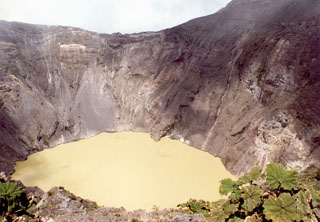Report on Irazu (Costa Rica) — May 1993
Bulletin of the Global Volcanism Network, vol. 18, no. 5 (May 1993)
Managing Editor: Edward Venzke.
Irazu (Costa Rica) Fumarolic activity; no deformation
Please cite this report as:
Global Volcanism Program, 1993. Report on Irazu (Costa Rica) (Venzke, E., ed.). Bulletin of the Global Volcanism Network, 18:5. Smithsonian Institution. https://doi.org/10.5479/si.GVP.BGVN199305-345060
Irazu
Costa Rica
9.979°N, 83.852°W; summit elev. 3436 m
All times are local (unless otherwise noted)
Subaqueous fumarolic activity from the N and SE parts of the crater lake continued in April and May. Bubbling was also observed and heard in the NE part of the lake, and observed in some spots in the N and NW sectors. A new area of N-S oriented bubbling sites was recognized along the N edge of the lake. Maximum lake temperature in the NE sector was 90.6°C. The turquoise-green to yellow-green lake has risen about 20 cm since March. New vegetation was observed growing in the lake. Table 5 summarizes lake characteristics during the last 2 years.
Table 5. Characteristics of the crater lake at Irazú since 17 July, 1991. Courtesy of Gerardo Soto, ICE.
| Characteristic | 17 Jul 1991 | 19 Nov 1991 | 03 Jun 1992 | 01 Dec 1992 | 11 May 1993 |
| Diameter (m) | 150 | 195 | 203 | 210 | 203 |
| Maximum Depth (m) | 4 | 14.3 | 15.4 | 16.1 | 15.4 |
| Volume (103 m3) | 70.7 | 263 | 296 | 320 | 296 |
| Water Temp (°C) | 30 | 26.7 | 26.2 | 23.6 | 24.7 |
| Minimum pH | 3.8 | 2.8 | 4.9 | 5.6 | 5.4 |
| Fumarole Temp (°C) | 92 | 92.3 | 90 | 92.6 | 91.5 |
The steaming ground area on the sediment fan N of the lake remains active, with some noise, and a maximum temperature of 89.5°C. Fumaroles on the NE side, in the dike area, were slightly hotter with a maximum of 91.5°C. The acidity and temperature of hot and cold springs around the volcano were unchanged in May.
Measurements of distance (lineal strain) and areal dilatation showed no changes from 13 January to 7 May. Precision leveling lines located 0.5 km and 3 km SE of the main crater also showed no significant changes. The network of dry-tilt stations detected an average tilt of 20 microradians between January and April on the SE flank, which is probably due to local effects. A seismic station 5 km SW of the active crater recorded four high-frequency events and other smaller magnitude microearthquakes.
Geological Summary. The massive Irazú volcano in Costa Rica, immediately E of the capital city of San José, covers an area of 500 km2 and is vegetated to within a few hundred meters of its broad summit crater complex. At least 10 satellitic cones are located on its S flank. No lava effusion is known since the eruption of the Cervantes lava flows from S-flank vents about 14,000 years ago, and all known Holocene eruptions have been explosive. The focus of eruptions at the summit crater complex has migrated to the W towards the main crater, which contains a small lake. The first well-documented eruption occurred in 1723, and frequent explosive eruptions have occurred since. Ashfall from the last major eruption during 1963-65 caused significant disruption to San José and surrounding areas. Phreatic activity reported in 1994 may have been a landslide event from the fumarolic area on the NW summit (Fallas et al., 2018).
Information Contacts: E. Fernández, J. Barquero, F. De Obaldía, T. Marino, R. Van Der Laat, V. Barboza, and R. Saenz, OVSICORI; G. Soto, ICE.

